Bunion Treatment Perth: Your Path to Comfort and Relief
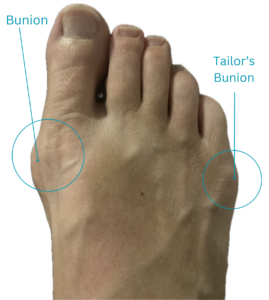
At Foot Focus Podiatry, we understand the discomfort and pain that come with bunions, a common yet often misunderstood foot condition. Our clinic in Perth is dedicated to providing expert care for bunions, with a special focus on non-surgical treatment options that can effectively alleviate pain, improve mobility, and prevent the condition from worsening.
Quick Scroll Options:
Why Choose Non-Surgical Bunion Treatment?
Bunions, or hallux valgus, are misalignments of the big toe joint that can cause significant pain, swelling, and difficulty walking. While surgery is sometimes necessary for severe cases, many patients can find relief through non-invasive treatments, especially when caught early. At Foot Focus Podiatry, we specialise in a range of non-surgical bunion treatments that can help manage symptoms, restore function, and even prevent the need for surgery.
Our Non-Surgical Bunion Treatments Include:
Wear Proper Footwear: Choose shoes with a wide toe box and good arch support to reduce pressure on the bunion.
Use Over-the-Counter Pain Relievers: Medications like ibuprofen can help reduce pain, swelling, and inflammation.
Custom Orthotic Inserts: Custom-made shoe inserts can provide additional support and help distribute pressure more evenly across the foot.
Bunion Pads or Cushions: Use soft pads or cushions designed for bunions to reduce friction and prevent irritation from shoes.
Toe Spacers or Bunion Splints: Wearing toe spacers or splints, especially at night, can help align the big toe and relieve pressure on the bunion.
Ice Therapy: Apply ice to the bunion several times a day to reduce swelling and soothe pain.
Foot Exercises: Stretching and strengthening exercises for the toes can improve flexibility and relieve discomfort.
Avoid High Heels: High heels can worsen bunion symptoms, so it’s best to avoid them as much as possible.
Seeking treatment early can help you manage your bunion symptoms more effectively and avoid the need for surgery. If treated properly, non-surgical interventions can slow or even halt the progression of bunions, allowing you to continue living an active, pain-free lifestyle.
Stages of Bunions

Mild
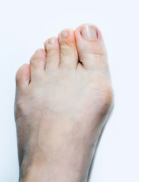
Moderate
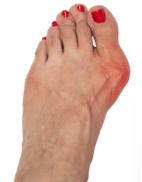
Large
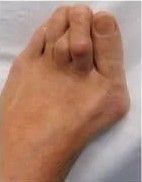
Severe

Mild

Moderate

Large

Severe
Bunion Surgery: A Secondary Option
In some cases, when conservative treatments fail to bring relief, bunion surgery may be recommended. Our clinic is fully equipped to assess your condition and discuss the best surgical options available. We collaborate with experienced surgeons to ensure that any surgical intervention is a well-informed decision based on your individual needs.
If you’d like to learn more about bunion surgery, our team provides thorough pre- and post-surgery care to ensure the best possible recovery and long-term results. Whether you opt for non-surgical treatment or surgery, we are here to guide you every step of the way.
Before and after Bunion Surgery
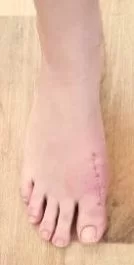
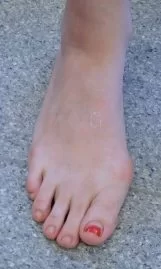
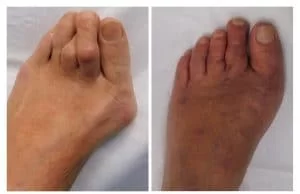
Figure 1 Figure 2

What Makes Us Different?
- 110 years of combined experience, including podiatrists who can trial conservative treatment with you first.
- 7 Podiatrists
- Podiatric surgeon with over 24 years of experience for complicated cases
- Our practice has been operating since 2000.
All of our podiatrists will explore all conservative options prior to sending you for a surgical consultation.
Our clinic supports you throughout your healthcare journey, offering conservative treatment when appropriate, as well as comprehensive pre- and post-surgical care, including rehabilitation services.
Reza Naraghi, is highly qualified and has also written many publications. To learn more about Dr Reza, please read more
What is a Bunion?
A bunion is a bony lump that forms at the joint between the big toe and the foot, often resulting from the big toe drifting toward the smaller toes, which can cause the joint to protrude and become painful. This condition, typically develops gradually and can be exacerbated by factors such as tight shoes or foot deformities. Bunions are characterised by a bulging bump on the base of the big toe, which may be accompanied by swelling, redness, and limited movement of the toe
Symptoms
The symptoms often include:
- redness
- swelling
- tenderness,
around the affected area, making it difficult to wear shoes or walk comfortably.
As the condition progresses, the bump on the side of the foot may become more prominent, and you may experience stiffness or limited mobility in the toe. In severe cases, the misalignment can affect balance and lead to additional foot pain or deformities.
Impact of Bunions on Balance and Gait
Bunions can significantly affect a person’s balance and gait, leading to an increased risk of falls, particularly in older adults.
This is due to several factors:
- Altered Gait Mechanics
- Bunions cause changes in walking patterns to compensate for pain and discomfort
- These alterations can lead to instability and a higher risk of falls
- Pain and Discomfort
- Bunion-related pain makes it challenging to maintain balance, especially on uneven surfaces
- Constant discomfort can affect overall mobility and stability
- Structural Changes
- Misalignment of the big toe limits its range of motion
- This affects weight distribution across the foot, impacting balance
- Reduced Mobility
- As bunions progress, they restrict movement of the big toe
- This limitation makes it harder to push off the ground and maintain balance
- Diabetic Patients
- Patients with diabetes experiencing bunions need to be especially careful with footwear
- Appropriate shoes are crucial to prevent pressure wounds or rubbing on bunions
Risk Factors of Untreated Bunions
- Age-Related Concerns
- Older adults are particularly vulnerable due to the progressive nature of bunions.
- This vulnerability is compounded by potential declines in overall balance and mobility.
- Untreated Bunions
- Leaving bunions untreated can lead to worsening pain and stiffness.
- This neglect may result in further complications that negatively impact balance and mobility.
- Increased risk of:
- Bursitis (painful, fluid-filled sacs around joints).
- Hammertoes/claw toes especially the 2nd toe.
- Osteoarthritis of the bunion joint and other midfoot joints.
- Other forefoot conditions such as Morton’s neuroma, plantar plate tears, joint synovitis etc.
Regardless of the risk factors involved, our experienced podiatrists are fully qualified to address your concerns and provide expert care for a wide range of conditions.
Note: COMMON CONFUSION
Many people think they have a bunion when it is actually a hallux limitus. For more information, click on hallux limitus for the common confusion

